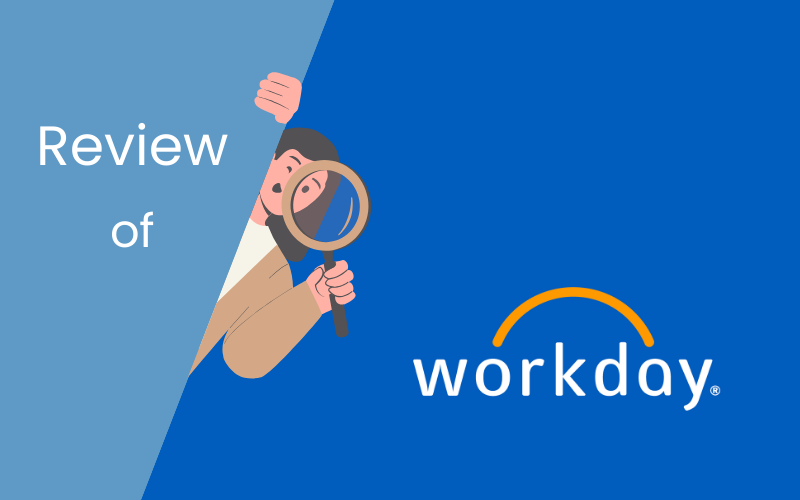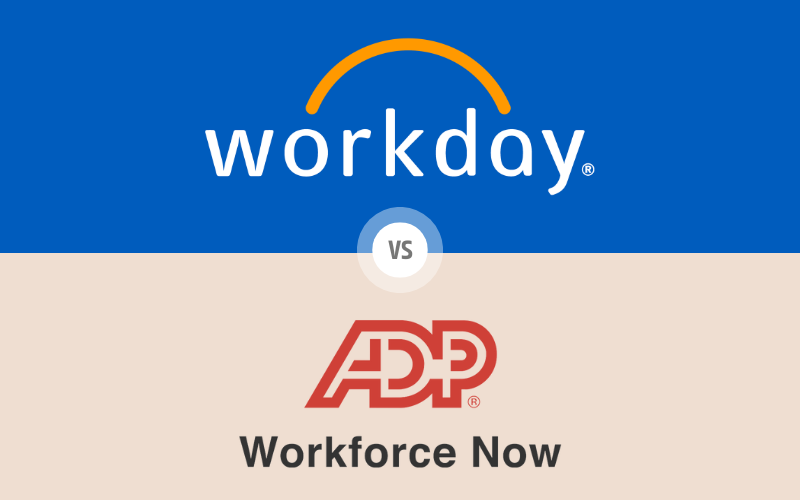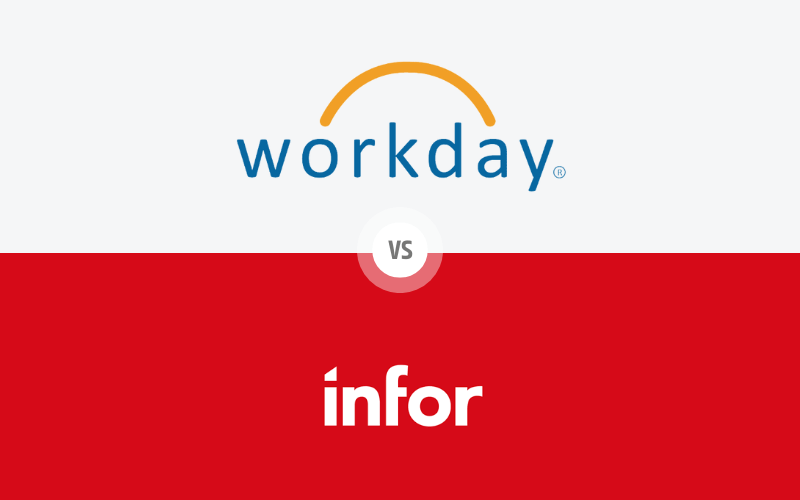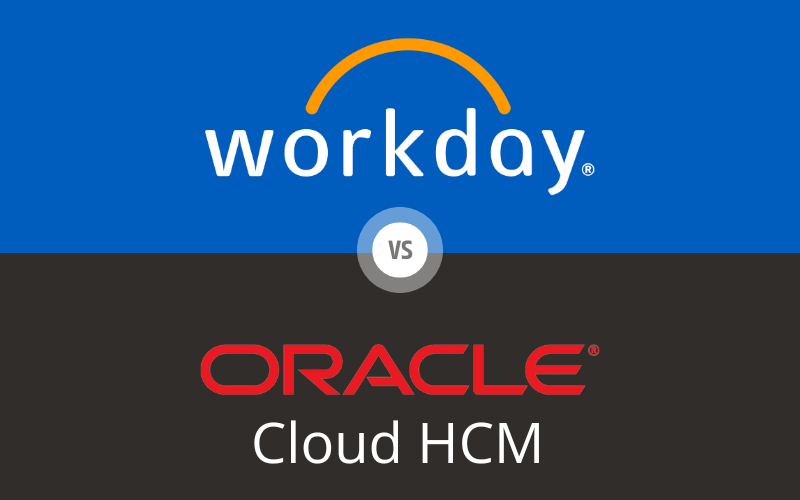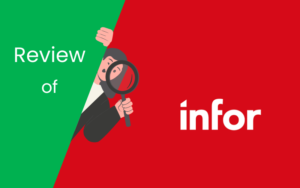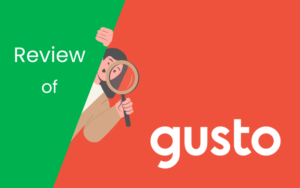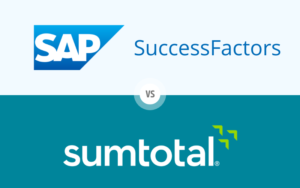This Workday review provides an in-depth exploration of Workday HCM, a pivotal player in the Human Capital Management (HCM) System sector. With a focus on optimizing HR operations, enhancing strategic planning, and improving overall organizational efficiency, Workday offers a suite of sophisticated tools and functionalities that are critical in today’s competitive marketplace. Our analysis covers a comprehensive range of features, from Workday’s intuitive user interface and robust integration capabilities to its exceptional performance in areas like payroll management and talent acquisition. We delve into how Workday supports diverse HR strategies and meets complex regulatory requirements, making it an ideal choice for enterprises aiming to transform their human resources landscape. Additionally, this review compares Workday with other top HCM systems, providing a clear perspective on its strengths and how it can serve as the backbone for transformative HR practices in various organizational contexts.
Table of Contents
User Interface and User Experience
In this comprehensive review of Workday, we delve deeply into the user interface (UI) and user experience (UX) aspects of this widely recognized Human Capital Management (HCM) system. Understanding both the strengths and potential limitations of Workday’s UI and UX is essential for organizations considering it as a viable solution for their HR management needs.
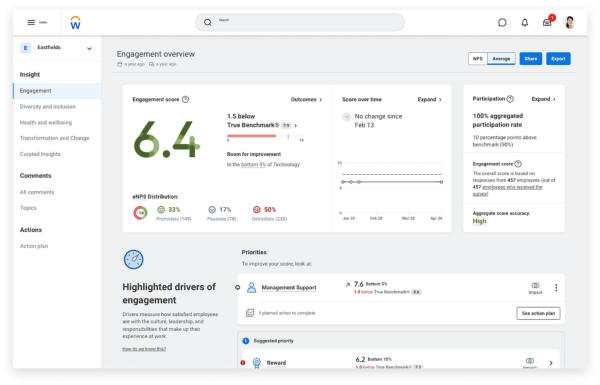
Overview of Workday’s UI and UX
Workday is praised for its thoughtful design approach, which integrates a clean and modern aesthetic with functional efficiency. The platform’s UI is intentionally developed to be visually appealing and straightforward, helping to eliminate visual clutter and streamline the navigation process. This clean design ethos is part of what makes Workday accessible to users across varying levels of tech proficiency, facilitating a smoother interaction with the platform’s extensive features.
Detailed Look at Intuitive Design
Workday’s interface is renowned for its intuitive layout, which significantly reduces the initial learning curve for new users. This intuitive design is evident in the logical arrangement of menu options and the straightforward presentation of information, which collectively speed up the adoption process across different departments. While the simplicity of the interface is highly beneficial for new users, it is important to note that accessing deeper, more complex functions may require additional exploration and training, which Workday supports through comprehensive online resources and user guides.
Customization and Personalization Capabilities
The customization features of Workday are a major highlight, offering each organization the ability to modify the system to better fit their specific needs. Users can personalize their dashboards to display critical information front and center, thus enhancing efficiency and engagement by making day-to-day tasks more accessible. Although the wide array of customizable options is a significant advantage, it can initially overwhelm new users. However, once mastered, these features allow for a highly tailored experience that can adapt to the evolving needs of the organization.
Mobile Responsiveness and Accessibility
The Workday mobile app is a robust extension of the desktop platform, designed to offer full functionality on the go. This mobile responsiveness ensures that users can complete essential HR tasks from anywhere, effectively supporting remote and field employees. The app is continually updated to improve usability and performance, although some users have noted occasional sluggishness. Workday is committed to refining these aspects, aiming to provide a seamless mobile experience that matches the desktop version.
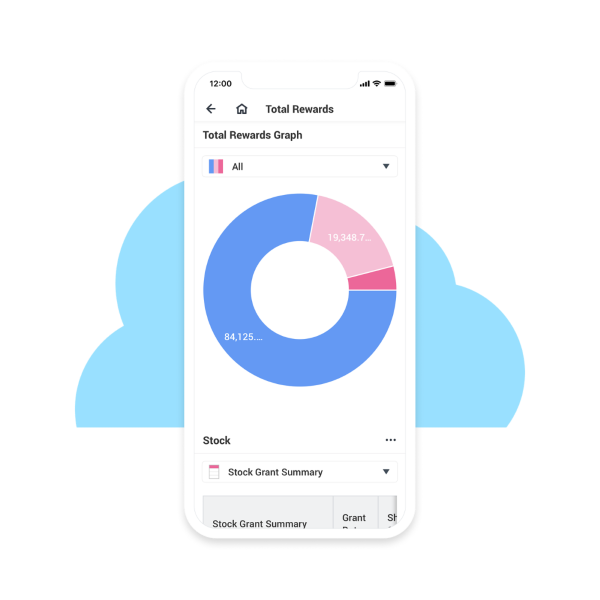
Engagement and User Interaction
Workday enhances user engagement through its use of interactive features like drag-and-drop functionality and real-time updates, which make navigating the system more dynamic and responsive. These interactive elements are designed to streamline the management of HR tasks, making the platform not just functional but enjoyable to use. However, without proper customization, these features can sometimes lead to a cluttered interface. Proper training and setup can help users take full advantage of these features while maintaining a clean user environment.
Evaluation of Pros and Cons
When considering Workday as your organization’s HCM system, it is crucial to weigh its advantages and potential drawbacks thoroughly.
Pros of Workday User Interface and User Experience
- Intuitive Design: The UI is designed to be easy to use, facilitating quick adoption and reducing the need for extensive training.
- Customization and Personalization: Offers extensive options for tailoring the system to meet the specific needs of users and the organization, enhancing user engagement.
- Mobile Responsiveness: The mobile app supports flexible work environments by allowing effective management of HR functions across devices.
- Interactive Features: Real-time updates and interactive elements make daily HR tasks more engaging and efficient.
Cons of Workday User Interface and User Experience
- Complex Customization Options: The wide range of customization can overwhelm users, complicating the UI and potentially leading to a steep learning curve.
- Mobile Performance Issues: Inconsistencies in the mobile app’s performance can impact the efficiency of users who rely on remote access.
- Risk of Interface Overload: The abundance of interactive elements can clutter the interface, complicating user interactions and detracting from the system’s efficiency.
Conclusion
The UI and UX of Workday are designed to support diverse business environments, aiming to streamline HR management and enhance operational efficiency. The platform stands out for its user-friendly design and customization capabilities, which, while presenting challenges in terms of complexity, also offer significant opportunities for enhancing workplace productivity and satisfaction. This review provides a balanced view, highlighting Workday’s strengths and areas for potential improvement, assisting businesses in making an informed decision about this powerful HCM solution.
Core HR Functions
In evaluating Workday Human Capital Management (HCM), it’s crucial to explore its core HR functions, which serve as the backbone of the system. These functions are designed to handle the fundamental aspects of human resources management, providing robust tools to support everyday HR activities efficiently.
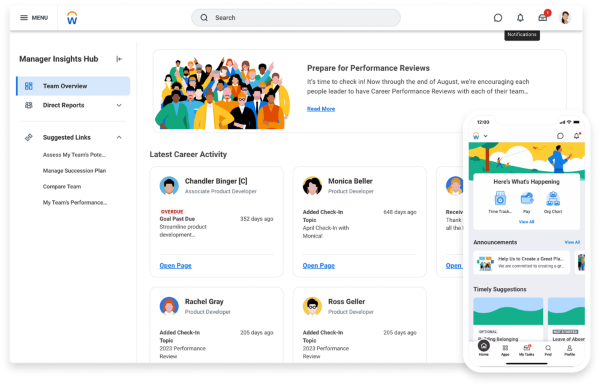
Overview of Core HR Capabilities
Workday provides a comprehensive suite of core HR functions that streamline various administrative tasks. This includes everything from employee data management to organizational structuring. The system’s integrated nature ensures that all core HR processes are interconnected, enhancing data accuracy and operational efficiency across the organization.
Detailed Employee Information Management
At the heart of Workday’s core HR functionalities is its sophisticated employee information management system. This feature allows HR professionals to maintain detailed profiles that include personal information, job roles, performance data, and career progression. The accessibility and accuracy of this data are paramount, as they inform many other HR processes, including payroll, benefits administration, and compliance.
Organizational Management and Structuring
Workday excels in organizational management by offering tools that help define and structure various business units, departments, and teams. This capability is essential for large organizations where hierarchy and clear structural delineations are crucial for smooth operations. Users can easily navigate and manage changes within the organization, aiding in better planning and resource allocation.
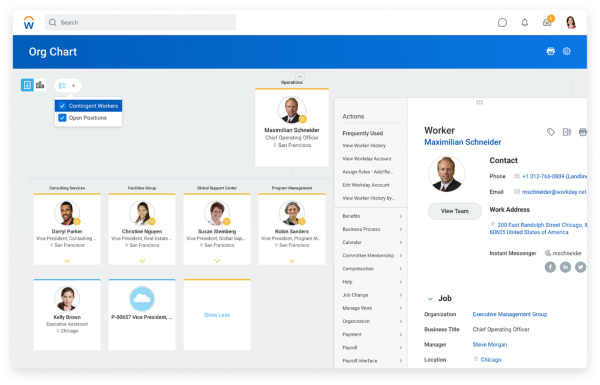
Absence and Leave Management
Efficient management of absences and leaves is another core HR function well-handled by Workday. The system provides configurable options to manage different types of leave policies, including vacation, medical leaves, and personal time off. These features help ensure compliance with local and international leave regulations while providing employees with a transparent and user-friendly interface to manage their leave requests.
Compliance and Regulatory Adherence
Compliance management is a significant aspect of Workday’s core HR functionalities. The system is updated regularly to keep pace with changing labor laws and regulations, reducing the risk of non-compliance. It also offers detailed reporting features that help HR departments prepare for audits and ensure that all company policies and procedures align with legal standards.
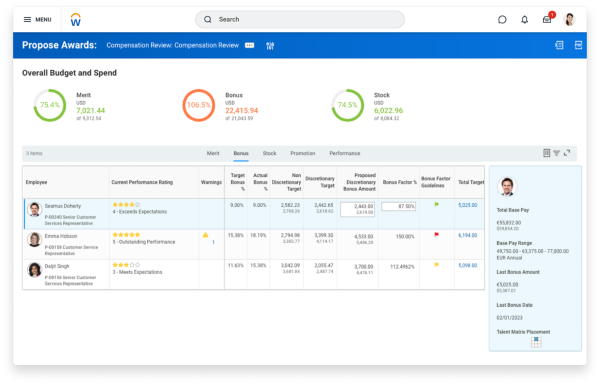
Evaluation of Pros and Cons
Understanding the strengths and limitations of Workday’s core HR functions is vital for organizations considering this system.
Pros of Workday Core HR Functions
- Comprehensive Employee Management: Offers detailed tracking and management of employee records, enhancing HR operations.
- Robust Organizational Structuring: Facilitates clear and efficient structuring of the organization, which is particularly beneficial for large, complex businesses.
- Effective Absence Management: Provides versatile tools for managing leaves, aiding in adherence to various regulatory standards.
- Strong Compliance Features: Ensures that businesses stay compliant with the latest laws and regulations, significantly reducing legal risks.
Cons of Workday Core HR Functions
- Complexity in Navigation: While comprehensive, the depth of features can sometimes make navigation and utilization challenging for new users.
- Dependence on Regular Updates: The need for frequent updates to maintain compliance can sometimes disrupt workflows if not managed properly.
Conclusion
Workday’s core HR functions are a cornerstone of its HCM solution, providing powerful tools to manage essential HR tasks efficiently. These functions support a wide range of HR activities, from detailed employee management to compliance and organizational structuring. While there are challenges related to complexity and the necessity of regular updates, the benefits of using Workday for core HR functions generally outweigh these drawbacks. This detailed evaluation offers potential users a clear insight into how Workday can meet their core HR needs, enhancing overall business operations and HR management.
Payroll Management
A critical component of any Human Capital Management (HCM) system is its ability to manage payroll effectively. Workday offers comprehensive payroll management capabilities that are designed to handle complex payroll requirements with precision and ease.
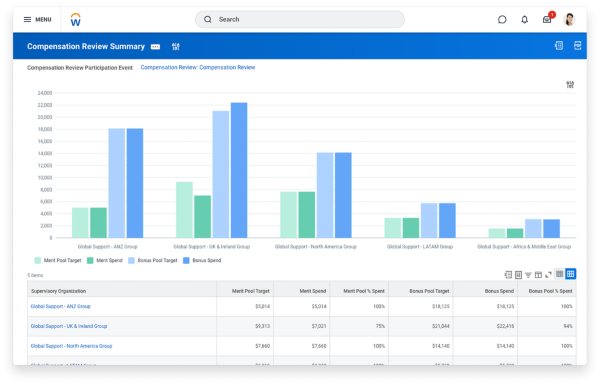
Overview of Payroll Capabilities
Workday’s payroll management is an integrated part of its broader HCM offerings, ensuring seamless data flow between HR functions and payroll. This integration is crucial for accuracy and efficiency, as it reduces the likelihood of errors and simplifies the overall payroll process.
Automation and Accuracy
A standout feature of Workday’s payroll management is its high degree of automation. The system automates essential payroll processes such as tax calculations, benefit deductions, and salary adjustments, which helps to minimize errors and reduce the administrative burden on HR staff. Additionally, Workday provides real-time payroll calculations, allowing for immediate previews of payroll results before final processing. This feature is invaluable for ensuring accuracy and compliance with financial regulations.
Compliance with Tax Regulations
Workday excels in managing payroll compliance, a critical aspect for businesses operating in multiple jurisdictions. The system is continually updated to comply with the latest tax laws and regulations, both locally and internationally. These updates ensure that the payroll system remains compliant with changing legal requirements, thereby reducing the risk of penalties or legal issues related to payroll inaccuracies.
Employee Self-Service Capabilities
Workday enhances the payroll experience by empowering employees through its self-service capabilities. Employees can access their pay slips, tax documents, and payroll history directly within the system. This transparency not only improves employee satisfaction by providing them with timely and easy access to their payroll information but also reduces the workload of HR departments by decreasing the number of inquiries they need to handle.
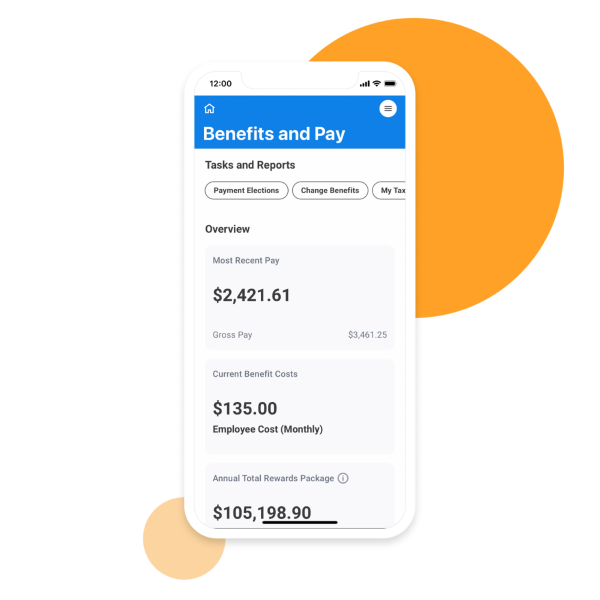
Global Payroll Management
For organizations operating across borders, Workday offers robust global payroll capabilities. The system can manage payroll operations in multiple countries, accommodating various currencies, languages, and regulatory requirements. This global functionality is particularly beneficial for multinational corporations looking for a unified solution that can handle diverse payroll needs.
Evaluation of Pros and Cons
To thoroughly assess Workday’s payroll management, it’s important to consider both its strengths and potential limitations.
Pros of Workday Payroll Management
- High Automation: Automates key payroll processes, significantly reducing the chance of human error and administrative workload.
- Real-Time Calculations: Allows for instant previews of payroll outcomes, ensuring accuracy before final submission.
- Comprehensive Compliance: Regular updates keep the system in line with current tax laws and regulations, ensuring compliance.
- Employee Self-Service: Empowers employees with direct access to their payroll data, enhancing transparency and satisfaction.
Cons of Workday Payroll Management
- Complexity in Configuration: Setting up and customizing the payroll system to meet specific organizational needs can be complex and time-consuming.
- Dependence on System Updates: While necessary for maintaining compliance, frequent system updates can occasionally disrupt established payroll workflows.
Conclusion
Workday’s payroll management capabilities are designed to streamline and secure the payroll process for organizations of all sizes. With features like high automation, compliance with tax regulations, and robust global payroll management, Workday provides a comprehensive solution that meets diverse payroll needs. While there are challenges associated with the complexity of setup and the need for regular updates, the overall benefits of using Workday for payroll management make it a compelling choice for businesses seeking an efficient and reliable payroll system.
Time and Attendance Tracking
Effective time and attendance management is vital for ensuring accurate payroll processing and compliance with labor regulations. Workday HCM offers robust tools to facilitate precise tracking of employee work hours and attendance, making it an essential component of the platform’s comprehensive human capital management capabilities.
Overview of Time and Attendance Features
Workday integrates time and attendance tracking directly into its broader HCM suite, enabling seamless data synchronization across HR functions. This integration ensures that time-related data accurately impacts payroll, benefits, and compliance reporting, enhancing overall administrative efficiency.
Automated Time Tracking System
Workday’s time tracking system automates the collection and validation of employee work hours. Employees can clock in and out through multiple methods, including web-based interfaces, mobile apps, and physical time clocks. This flexibility supports various work environments and employee preferences, promoting accuracy and ease of use. The system automatically updates attendance records in real time, reducing the potential for errors and the need for manual adjustments.
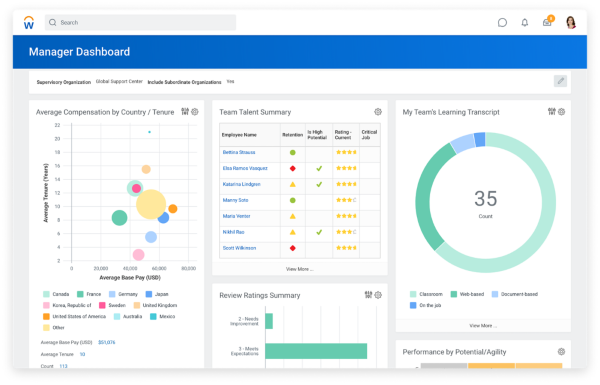
Configurable Work Schedules
Workday provides configurable scheduling tools that allow organizations to set up standard and alternative work schedules to meet their operational needs. These tools support shift planning, flexible working hours, and part-time arrangements, accommodating a diverse workforce. Managers can quickly adjust schedules in response to changes in workload or employee availability, ensuring optimal staffing levels at all times.
Leave and Absence Management
Workday excels in managing employee absences with a comprehensive module that handles all types of leave, including vacation, sick leave, and parental leave. The system enables employees to request time off directly through the platform, which managers can approve or modify as needed. This module is fully integrated with the rest of Workday’s functions, ensuring that time off is accurately reflected in payroll calculations and compliance reports.
Compliance with Labor Laws
An integral part of Workday’s time and attendance tracking is its ability to help organizations comply with local and international labor laws. The system includes features to monitor work hours and ensure adherence to regulations such as overtime, minimum rest periods, and maximum working hours. Regular updates to the system help keep compliance measures current with the latest legal standards.
Evaluation of Pros and Cons
To assess Workday’s time and attendance tracking effectively, it is important to consider both its advantages and limitations.
Pros of Workday Time and Attendance Tracking
- Automated Tracking: Minimizes errors and reduces administrative overhead by automating the collection and updating of time records.
- Flexible Scheduling: Supports various employment types and work arrangements, enhancing workforce management flexibility.
- Integrated Leave Management: Streamlines the process of managing and approving leaves, improving HR efficiency and employee satisfaction.
- Compliance Features: Helps ensure compliance with labor regulations, reducing the risk of legal issues and fines.
Cons of Workday Time and Attendance Tracking
- Complexity of Setup: Configuring the system to meet specific organizational rules can be complex and may require significant initial setup time.
- Dependence on Accurate Data Entry: While automated, the system’s effectiveness can be compromised by incorrect data inputs from users.
Conclusion
Workday’s time and attendance tracking capabilities provide a robust framework for managing workforce attendance and compliance with labor laws. The system’s integration with other HR functions, combined with its flexibility and comprehensive features, makes it an invaluable tool for organizations looking to streamline their time management practices. Despite challenges related to system setup and data entry, the benefits of using Workday for time and attendance tracking are substantial, making it a strong contender for businesses seeking an integrated solution to manage their human capital efficiently.
Benefits Administration
Efficient management of employee benefits is a key feature of Workday HCM, designed to simplify complex benefits administration tasks while enhancing user experience and compliance. This module supports a wide range of benefits programs, helping organizations streamline their offerings and improve employee satisfaction.
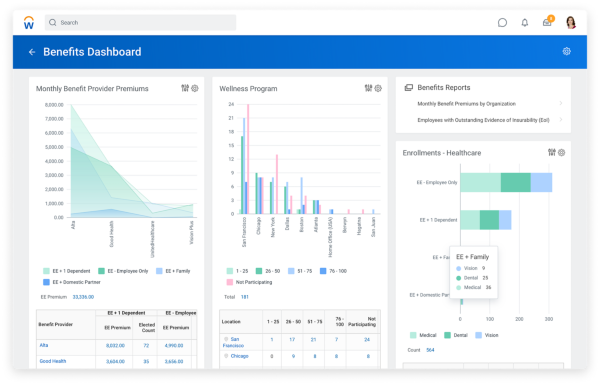
Overview of Benefits Administration Capabilities
Workday’s benefits administration module is fully integrated with its broader HCM platform, ensuring that benefits data is accurately synchronized with other HR processes, such as payroll and compliance. This integration aids in maintaining consistency across all HR systems, reducing errors, and improving efficiency.
Flexible Benefits Management
Workday provides a flexible benefits management system that allows HR teams to customize benefits packages to meet diverse employee needs and organizational goals. Employers can configure and manage multiple types of benefits, including health insurance, retirement plans, wellness programs, and more. The system’s configurability ensures that organizations can adapt to changing benefits landscapes and employee expectations without cumbersome administrative overhead.
Employee Self-Service Portal
A significant strength of Workday’s benefits administration is its robust employee self-service capabilities. Employees can access the portal to view their current benefits, enroll in new benefits during open enrollment periods, and make changes due to life events such as marriage or the birth of a child. This self-service functionality empowers employees by giving them direct control over their benefits selections, leading to increased engagement and satisfaction.
Automated Benefits Enrollment
Workday automates the enrollment process, reducing the administrative burden on HR departments and ensuring that employees receive their benefits entitlements promptly. Automation extends to eligibility checks, which the system performs in real-time, ensuring that only qualified employees enroll in specific benefits programs. This automation helps prevent errors and improves the overall efficiency of the benefits administration process.
Compliance and Reporting
Workday includes comprehensive tools to help ensure compliance with local and federal regulations affecting employee benefits. The system is regularly updated to reflect the latest changes in legislation, such as the Affordable Care Act in the United States. Additionally, Workday provides detailed reporting capabilities that allow HR teams to monitor adherence to these regulations and prepare for audits or compliance reviews effectively.
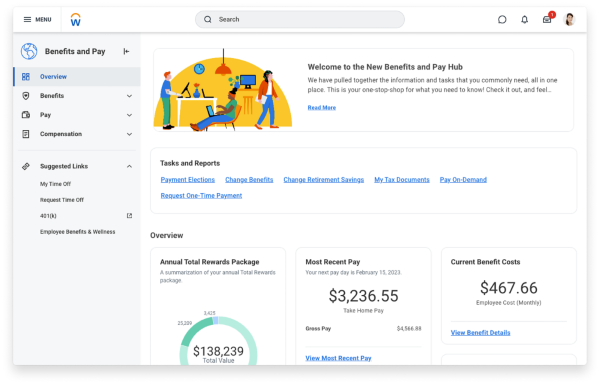
Evaluation of Pros and Cons
When considering Workday for benefits administration, it’s crucial to weigh its strengths against its potential limitations.
Pros of Workday Benefits Administration
- Flexible Management: Supports a wide range of benefits options and configurations to suit diverse workforce needs.
- Employee Self-Service: Empowers employees with direct access to their benefits information, enhancing transparency and satisfaction.
- Automated Processes: Reduces manual workloads by automating enrollment and eligibility verifications.
- Strong Compliance Tools: Ensures adherence to applicable benefits laws and regulations, minimizing legal risks.
Cons of Workday Benefits Administration
- Complexity of Configuration: The initial setup and ongoing management of the benefits module can be complex, especially in organizations with diverse and dynamic benefits needs.
- Dependence on Accurate Data: The effectiveness of automated features depends heavily on the accuracy of the data entered into the system.
Conclusion
Workday’s benefits administration module offers powerful tools that are designed to streamline the management of employee benefits through robust automation, flexible configurations, and comprehensive compliance features. While the system may present challenges in terms of setup complexity and data dependence, the overall advantages of using Workday for benefits administration make it a compelling choice for organizations looking to optimize their benefits offerings and improve HR operations.
Performance Management
Effective performance management is critical to fostering employee growth and organizational success. Workday HCM provides a robust framework for tracking, analyzing, and enhancing employee performance through its integrated performance management system.
Overview of Performance Management Capabilities
Workday integrates performance management seamlessly within its HCM suite, facilitating a unified approach to managing employee performance data alongside other HR functions. This integration ensures consistency in data handling and enhances the strategic use of performance insights across the organization.
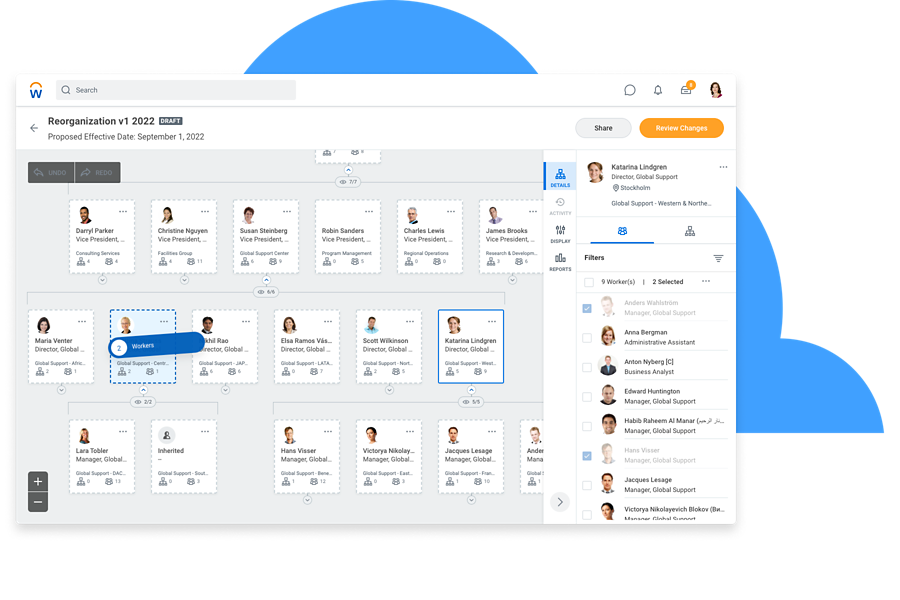
Goal Setting and Alignment
Workday allows organizations to set and manage individual and team goals that align with broader business objectives. This feature supports transparent goal-setting processes where employees and managers can collaboratively define clear, measurable objectives. The system tracks progress against these goals, providing real-time feedback and enabling adjustments as needed to ensure alignment with changing organizational priorities.
Continuous Feedback and Evaluations
A key component of Workday’s performance management is its support for continuous feedback and regular performance evaluations. The system facilitates ongoing conversations between employees and managers, helping to maintain focus on objectives and encourage professional development. This model of continuous assessment helps organizations move away from traditional annual review cycles to a more dynamic and responsive performance management strategy.
360-Degree Feedback
Workday supports 360-degree feedback mechanisms, allowing employees to receive performance insights from peers, subordinates, and supervisors, in addition to self-assessments. This comprehensive feedback provides a well-rounded view of employee performance and areas for improvement, fostering a culture of transparency and continuous development.
Talent and Succession Planning
Integrating performance management with talent and succession planning, Workday helps organizations identify and nurture high-potential employees for future leadership roles. The system includes tools for creating development plans that are tied to performance outcomes, ensuring that career progression opportunities are based on objective performance metrics.
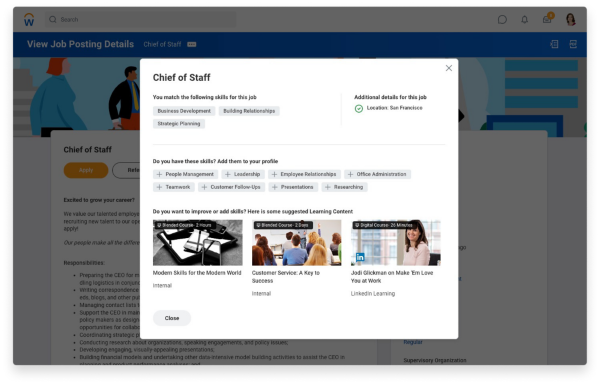
Evaluation of Pros and Cons
To effectively evaluate Workday’s performance management system, it is important to consider both its advantages and potential drawbacks.
Pros of Workday Performance Management
- Goal Alignment: Facilitates the alignment of individual goals with company objectives, enhancing organizational coherence.
- Continuous Feedback: Supports a culture of ongoing communication and development, which is crucial for adapting to rapid market changes.
- Comprehensive Feedback: The 360-degree feedback process enriches the evaluation system, providing employees with diverse perspectives on their performance.
- Integrated Planning: Links performance outcomes with career development opportunities, fostering a motivated and engaged workforce.
Cons of Workday Performance Management
- Complexity of Features: The breadth of features, while beneficial, can be complex to navigate and utilize effectively without proper training.
- Resource Intensiveness: Implementing and maintaining an effective performance management system requires significant time and resources, which may be a challenge for smaller organizations.
Conclusion
Workday’s performance management capabilities offer a sophisticated approach to enhancing workforce productivity and engagement through goal alignment, continuous feedback, and integrated development planning. While there are challenges associated with the complexity and resource requirements of the system, the strategic benefits of deploying Workday for performance management make it a valuable tool for organizations aiming to optimize their human capital potential. This comprehensive system helps businesses not only track performance but also drive significant growth by aligning employee achievements with organizational goals.
Talent Management and Recruiting
Talent management and recruiting are pivotal to sustaining organizational growth and competitive advantage. Workday HCM provides an integrated approach to these critical HR functions, ensuring that businesses can attract, manage, and retain top talent effectively.
Overview of Talent Management and Recruiting Capabilities
Workday combines various aspects of talent management and recruiting into a cohesive system that enhances the entire employee lifecycle, from hiring to retirement. This integration ensures that data flows seamlessly between processes, aiding in better decision-making and more efficient management of human resources.
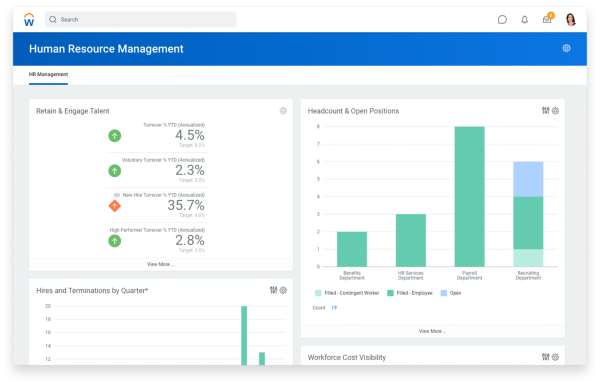
Streamlined Recruitment Process
Workday simplifies the recruitment process with tools designed to optimize every stage, from job posting to candidate selection. The system allows for the creation of engaging job descriptions and efficient management of job postings across multiple platforms. Applicants can easily submit their information through user-friendly interfaces, and recruiters can quickly track and manage applications. Workday also includes features for screening and interviewing candidates, ensuring that the recruitment process is both thorough and efficient.
Enhanced Candidate Experience
A key focus of Workday’s talent management functionality is providing a positive candidate experience. The system enables seamless communication between recruiters and candidates, facilitating timely updates and feedback throughout the recruitment process. This attention to candidate engagement helps build a positive brand image and increases the likelihood of attracting top talent.
Comprehensive Talent Development
Workday supports continuous talent development through personalized training programs and development plans tailored to individual career goals. The system integrates learning and development with performance management, allowing for development initiatives to be directly aligned with performance feedback and business needs. This integration helps ensure that employee growth is aligned with organizational objectives, enhancing overall productivity and satisfaction.
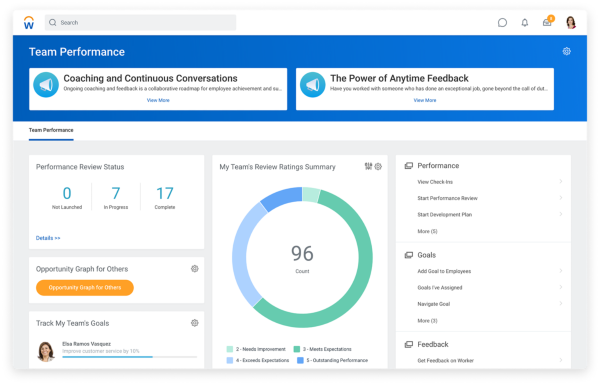
Succession Planning
Workday includes advanced tools for succession planning, helping organizations prepare for future leadership needs. By identifying high-potential employees and providing targeted development opportunities, Workday ensures that there is a robust pipeline of talent ready to step into key roles. This proactive approach to succession planning supports long-term business continuity and leadership stability.
Evaluation of Pros and Cons
When assessing Workday’s talent management and recruiting capabilities, it is crucial to consider both the strengths and limitations of the system.
Pros of Workday Talent Management and Recruiting
- Streamlined Recruitment: Automates and organizes the recruitment process, making it more efficient and less resource-intensive.
- Candidate Engagement: Enhances the recruitment experience for candidates, aiding in employer branding and talent attraction.
- Integrated Development: Links learning and development with performance management to tailor growth opportunities to individual and organizational needs.
- Proactive Succession Planning: Identifies and prepares future leaders, securing organizational leadership for the coming years.
Cons of Workday Talent Management and Recruiting
- Complexity in Customization: While highly customizable, the system can be complex to configure, particularly for specific industry or regional requirements.
- Resource Intensity: Effective implementation and management of the talent and recruiting modules may require substantial training and HR resources.
Conclusion
Workday’s talent management and recruiting module offers a robust set of tools designed to enhance the efficiency and effectiveness of HR practices related to talent acquisition and development. While the system presents some challenges in terms of customization and resource requirements, its comprehensive capabilities make it an invaluable asset for organizations aiming to optimize their human capital management strategies. This integration not only supports better talent practices but also aligns closely with broader business goals, driving organizational success through improved human resource management.
Learning and Development
Workday HCM excels in providing a comprehensive Learning and Development (L&D) module designed to support continuous growth and skill enhancement for employees. This aspect of Workday is integral for organizations looking to foster a culture of learning and adaptability among their workforce.
Overview of Learning and Development Features
Workday integrates its L&D capabilities within the broader HCM suite, ensuring seamless interaction between learning activities and other HR functions like performance management and career planning. This holistic approach aids organizations in aligning employee development efforts with strategic business goals.
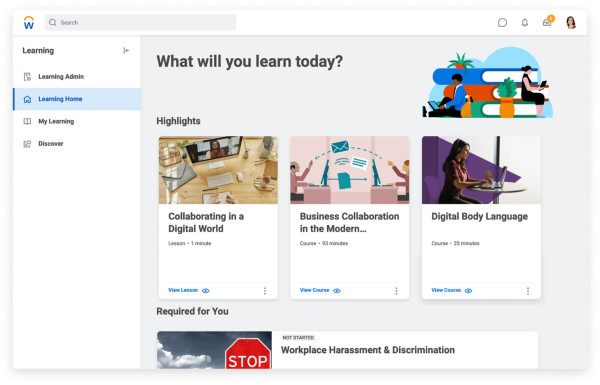
Personalized Learning Experiences
A standout feature of Workday’s L&D module is its ability to deliver personalized learning experiences. The system allows for the creation of individual learning paths that can be customized to match the career goals and skills gaps of each employee. Workday uses machine learning algorithms to suggest relevant training, courses, and content, making learning recommendations more targeted and effective.
Collaborative and Social Learning
Workday promotes an interactive learning environment by incorporating social learning functionalities. This includes tools for sharing content, peer learning forums, and collaborative spaces where employees can engage with each other and with subject matter experts. These features not only enhance learning retention but also encourage a more dynamic and engaging learning culture within the organization.
Integration with Performance Management
The L&D tools in Workday are closely integrated with its performance management system. This integration allows managers and employees to identify development opportunities based on performance reviews and feedback. Learning objectives can be directly linked to performance goals, ensuring that L&D efforts are clearly focused on both personal growth and organizational needs.
Compliance and Certification Tracking
Workday also supports compliance training by tracking certification completions and renewals. Organizations can set up mandatory training programs within the system, and Workday will automatically remind employees of upcoming deadlines for compliance-related courses. This feature is essential for maintaining standards and adhering to industry regulations, particularly in highly regulated sectors.
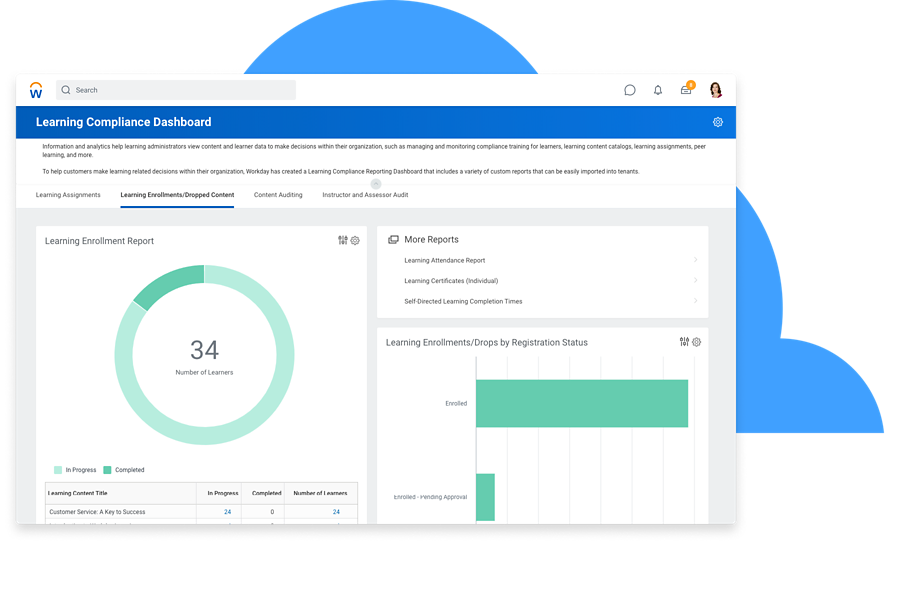
Evaluation of Pros and Cons
Understanding the advantages and limitations of Workday’s Learning and Development module is crucial for organizations considering its implementation.
Pros of Workday Learning and Development
- Personalized Learning Paths: Tailors learning experiences to individual needs, enhancing relevance and engagement.
- Social Learning Capabilities: Fosters a collaborative learning environment that promotes knowledge sharing and community learning.
- Integrated Performance Management: Aligns learning and development activities with business goals and performance outcomes.
- Compliance Management: Automates tracking and notifications for required certifications and training, ensuring compliance.
Cons of Workday Learning and Development
- Complexity of Setup: The system’s comprehensive features can be complex to configure and may require significant setup time.
- Resource Intensive: To fully leverage the L&D module, organizations might need to invest in additional resources, including content development and training administration.
Conclusion
Workday’s Learning and Development module provides robust tools designed to support a lifelong learning culture within organizations. Its capabilities extend from personalized learning pathways to integrated performance management, making it a powerful solution for enhancing employee skills and aligning development efforts with strategic objectives. While the implementation and maintenance of Workday’s L&D system may require substantial investment, the potential benefits in workforce capability and adaptability can significantly outweigh these challenges, making it an excellent choice for forward-thinking organizations.
Reporting and Analytics
Workday HCM excels in providing advanced reporting and analytics capabilities, essential for making informed decisions and driving strategic HR initiatives. This robust feature set is designed to help organizations harness the power of data across all facets of human resources.
Overview of Reporting and Analytics Features
Workday integrates its reporting and analytics directly within the HCM suite, offering real-time insights and comprehensive data access. This integration ensures that HR leaders and business managers have the necessary tools to analyze workforce trends, optimize processes, and predict future HR needs effectively.
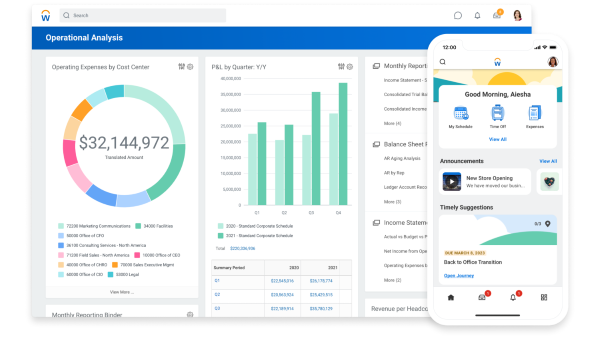
Advanced Data Visualization
Workday offers a range of customizable dashboards and data visualization tools that make complex datasets accessible and understandable. Users can create and modify reports to visualize key HR metrics such as employee turnover, hiring rates, and performance outcomes. These visual tools help clarify insights, making it easier for decision-makers to identify trends and patterns that might not be obvious from raw data alone.
Real-Time Reporting Capabilities
One of the standout features of Workday’s analytics is its ability to deliver real-time data insights. This capability allows HR professionals to access up-to-date information whenever they need it, enabling responsive decision-making. Real-time reporting is particularly beneficial in dynamic business environments where conditions change rapidly, and timely data is crucial for maintaining operational agility.
Predictive Analytics and Forecasting
Workday incorporates predictive analytics into its reporting toolkit, providing forecasts based on historical data and current trends. These predictive insights can help organizations anticipate workforce challenges and opportunities, such as potential skill shortages, employee turnover risks, and future hiring needs. By leveraging predictive analytics, businesses can proactively address issues before they impact the organization.
Comprehensive Compliance Reporting
Maintaining compliance with regulatory requirements is a critical aspect of HR management. Workday facilitates this through detailed compliance reports that track everything from diversity metrics to labor standards adherence. The system can be set to alert managers to potential compliance issues, ensuring that organizations stay ahead of regulatory changes and avoid potential penalties.
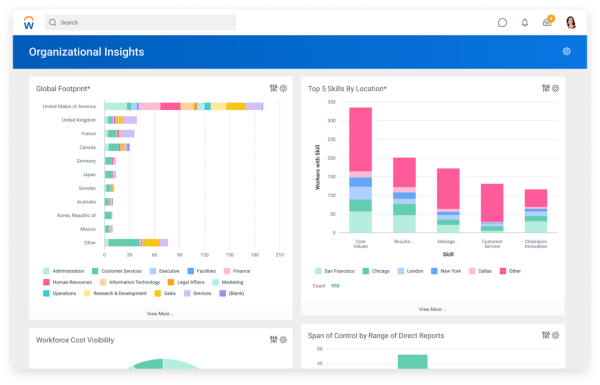
Evaluation of Pros and Cons
When evaluating Workday’s reporting and analytics, it is important to consider both its strengths and potential challenges.
Pros of Workday Reporting and Analytics
- Advanced Visualization Tools: Enhance the understanding of complex data sets, making it easier to communicate insights across the organization.
- Real-Time Data Access: Provides immediate insights into HR metrics, supporting agile decision-making.
- Predictive Analytics: Helps foresee future trends and challenges, allowing for proactive strategic planning.
- Compliance Reporting: Automates and simplifies the tracking of regulatory compliance, reducing risk.
Cons of Workday Reporting and Analytics
- Complexity of Features: The depth and breadth of available data can be overwhelming for users without analytical training.
- Resource Intensive: Maximizing the benefits of advanced analytics features may require additional resources and expertise.
Conclusion
Workday’s reporting and analytics capabilities are a powerful tool for organizations seeking to gain deeper insights into their human capital and drive data-driven HR strategies. With features ranging from real-time reporting to predictive analytics, Workday supports informed decision-making and strategic planning. While there are challenges related to the complexity of data analysis and the need for specialized skills, the strategic advantages provided by Workday’s comprehensive analytics platform make it a valuable investment for businesses committed to leveraging data for HR success.
Compliance and Security
In the realm of human resources, maintaining compliance with regulatory requirements and ensuring robust security are critical challenges. Workday HCM addresses these challenges head-on with a comprehensive suite of compliance and security features designed to protect sensitive data and help organizations meet various legal standards.
Overview of Compliance and Security Features
Workday integrates compliance and security functionalities seamlessly within its broader HCM platform, ensuring that these critical aspects are not isolated but are a part of every process. This approach helps in maintaining a consistent security posture and compliance strategy across all HR functions.
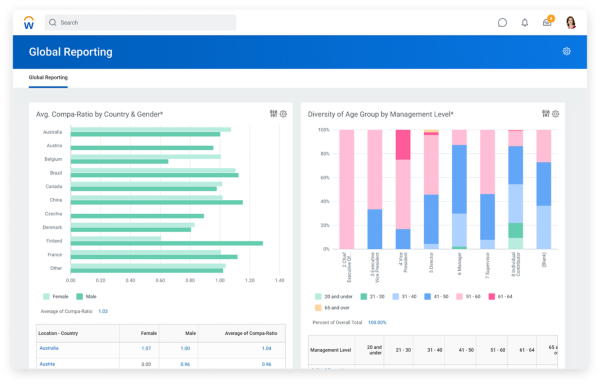
Robust Data Protection Measures
Workday employs advanced security protocols to safeguard sensitive employee information. Data encryption both in transit and at rest, multi-factor authentication, and rigorous access controls are standard features that ensure data integrity and confidentiality. Workday’s commitment to security is evident in its adherence to industry best practices and certifications, making it a trusted platform for organizations concerned with data security.
Automated Compliance Tools
Workday provides automated tools that significantly ease the burden of compliance management. The system is designed to stay updated with the latest changes in employment laws and regulations across different jurisdictions. It can automatically adjust processes and policies to comply with new legal requirements, thereby reducing the risk of non-compliance and associated penalties.
Real-Time Auditing Capabilities
A key feature of Workday’s compliance functionality is its real-time auditing capabilities. The system logs all transactions and changes, allowing for detailed audits that can be conducted at any time. This continuous monitoring not only helps in ensuring compliance but also aids in identifying and addressing potential issues proactively.
Customizable Compliance Reporting
Workday allows organizations to generate customizable reports tailored to meet specific regulatory requirements. Whether it’s reports for EEO compliance, ACA tracking, or any other regulatory standard, Workday provides the tools necessary to create detailed documentation that can support compliance efforts during audits or reviews.
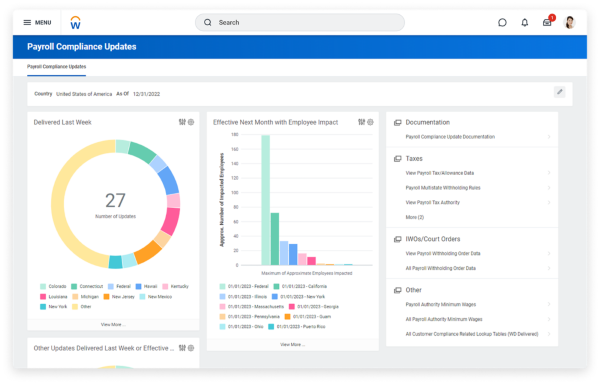
Evaluation of Pros and Cons
Assessing Workday’s compliance and security features requires a balanced view of its strengths and limitations.
Pros of Workday Compliance and Security
- Comprehensive Data Protection: Strong encryption and access controls protect against unauthorized access and data breaches.
- Automated Compliance Updates: Keeps the system up-to-date with the latest legal changes, minimizing manual updates and potential human errors.
- Real-Time Auditing: Enhances transparency and accountability, supporting thorough compliance practices.
- Customizable Reporting: Offers flexibility in compliance reporting, ensuring that specific regulatory requirements are met.
Cons of Workday Compliance and Security
- Complexity of Configuration: Setting up and customizing security settings and compliance parameters can be complex and require specialized knowledge.
- Resource Intensity: Maintaining high compliance and security standards demands continuous attention and investment in resources.
Conclusion
Workday’s compliance and security features are integral components of its HCM solution, offering robust protections and ease of compliance that are essential for modern organizations. While there are challenges related to the complexity of setup and ongoing management, the comprehensive nature of Workday’s security and compliance functionalities make it a formidable tool in protecting sensitive data and adhering to regulatory standards. For organizations looking for a reliable and secure HCM system, Workday presents a compelling choice that balances advanced security measures with comprehensive compliance management tools.
Integration and Compatibility
In today’s diverse IT landscape, the ability of an HCM system to integrate smoothly with other business systems and maintain compatibility across various platforms is crucial. Workday HCM excels in these areas, providing flexible and robust integration and compatibility features that enhance overall HR operational efficiency.
Overview of Integration Capabilities
Workday is designed to function seamlessly within a complex ecosystem of business applications, supporting a wide range of integrations with other software systems including ERP (Enterprise Resource Planning), financial systems, and other HR-related applications. This interoperability is critical for maintaining data consistency and ensuring efficient workflow across different business functions.
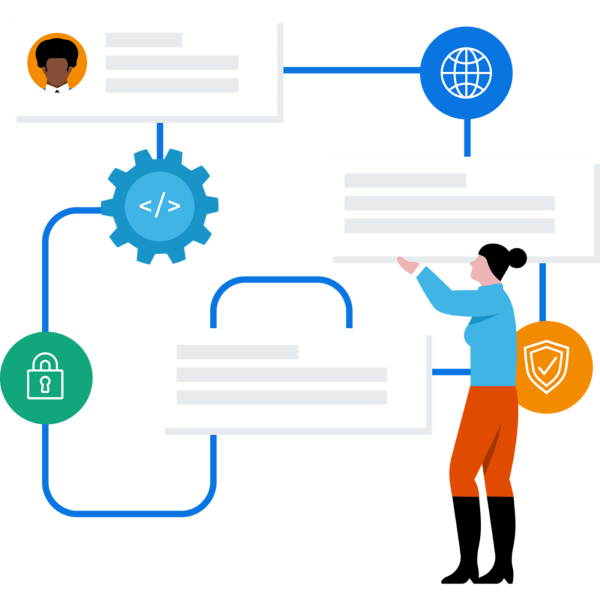
Extensive API Support
Workday offers extensive APIs (Application Programming Interfaces) that allow for custom integrations, making it adaptable to specific organizational needs. These APIs are well-documented and supported, enabling developers to connect Workday with both legacy systems and modern applications. This flexibility is essential for organizations looking to maintain a cohesive technology strategy without replacing their existing systems.
Compatibility Across Devices and Platforms
Workday ensures that its platform is compatible with various operating systems such as Windows and MacOS, and is accessible on a range of devices including desktops, laptops, tablets, and smartphones. This broad compatibility helps in supporting a diverse workforce that uses multiple device types and operating systems, thereby enhancing user access and productivity.
Cloud-Based Architecture
The cloud-based nature of Workday contributes significantly to its integration capabilities. Being hosted in the cloud means that Workday can offer real-time updates, scalable infrastructure, and seamless integration with other cloud services. This architecture not only reduces the need for extensive on-premise IT infrastructure but also ensures that the system is always up-to-date with the latest features and security standards.
Seamless Data Synchronization
A key benefit of Workday’s integration capabilities is the seamless synchronization of data across various systems. This synchronization ensures that all changes in Workday are automatically reflected in other connected systems, eliminating the need for manual data entry and reducing the risk of errors. Whether updating employee information, processing payroll, or tracking time and attendance, Workday maintains consistent and accurate data throughout the organization.
Evaluation of Pros and Cons
While Workday provides robust integration and compatibility features, it is important to consider both the advantages and potential challenges.
Pros of Workday Integration and Compatibility
- Flexible API Support: Facilitates custom integrations, allowing organizations to tailor the system to their specific requirements.
- Broad Compatibility: Supports a wide range of devices and operating systems, enhancing accessibility and user experience.
- Cloud-Based Benefits: Offers scalability, automatic updates, and easy integration with other cloud services.
- Seamless Data Synchronization: Ensures accuracy and consistency across all connected systems.
Cons of Workday Integration and Compatibility
- Dependency on Internet Connectivity: Being cloud-based, Workday requires a stable internet connection, which could be a limitation in areas with poor connectivity.
- Complexity in Initial Setup: Integrating multiple systems can be complex and may require significant technical expertise.
Conclusion
Workday’s integration and compatibility features stand out as key strengths in its HCM offering, providing the flexibility and efficiency needed in modern IT environments. By supporting extensive customizations, broad device compatibility, and seamless data integration, Workday enables organizations to enhance their HR operations and leverage their technology investments effectively. Despite some challenges related to initial setup and internet dependency, the benefits of Workday’s integration capabilities make it a powerful tool for businesses aiming to optimize their human resource management systems.
Customer Support and Service
Effective customer support and service are pivotal in maximizing the value of Human Capital Management (HCM) systems. Workday HCM is committed to providing robust customer support that ensures users can fully leverage the system’s capabilities to meet their organizational needs.
Overview of Customer Support Offerings
Workday provides a comprehensive support structure that includes multiple channels of assistance, ensuring that users can find help in the manner that best suits their preferences. Whether through phone support, email, live chat, or online knowledge bases, Workday aims to resolve user issues promptly and effectively.
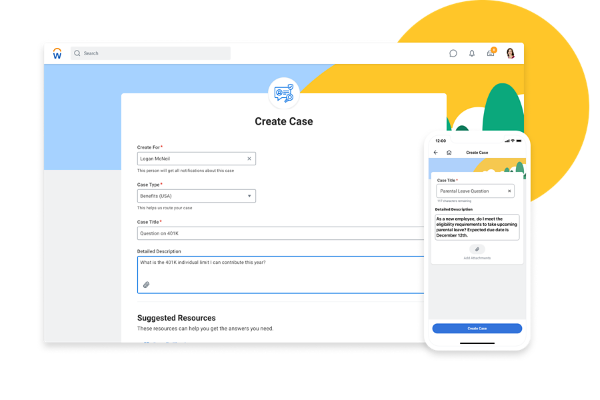
Dedicated Support Teams
Workday boasts dedicated customer success teams that work closely with clients to ensure smooth system implementation and ongoing usage. These teams offer personalized support and are equipped to handle a wide range of inquiries and issues, from simple usage questions to complex integration challenges. Their proactive approach helps in not only resolving issues but also in preventing potential problems before they arise.
Extensive Training Resources
Understanding the importance of effective user training, Workday offers a variety of training options designed to enhance system adoption and proficiency. These resources include webinars, interactive e-learning modules, and on-site training sessions that cater to different learning styles and needs. This comprehensive training helps users understand how to utilize all the features of Workday effectively, maximizing the system’s value to the organization.
Community Engagement and Support
Workday encourages a strong sense of community among its users by providing access to forums and user groups. These platforms allow users to share tips, discuss best practices, and provide peer support. Engaging with the community not only helps users solve problems more quickly but also fosters a collaborative environment where they can learn from each other’s experiences.
Continuous Improvement Based on Feedback
Workday places a high value on user feedback for continuous improvement of its support services and software updates. The system includes mechanisms to gather and analyze feedback regularly, which helps Workday align its development and support services with user needs and expectations.
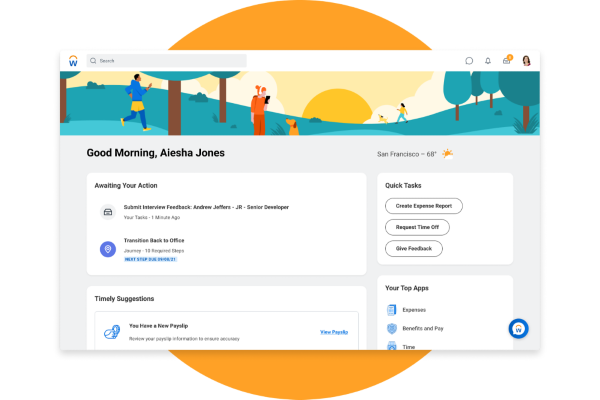
Evaluation of Pros and Cons
To fully evaluate Workday’s customer support and service, it is important to consider both the advantages and limitations.
Pros of Workday Customer Support and Service
- Multiple Support Channels: Provides flexibility and accessibility, ensuring users can obtain help through their preferred contact method.
- Dedicated Support Teams: Offers expert assistance tailored to the specific needs of the organization, enhancing user satisfaction and system effectiveness.
- Comprehensive Training Resources: Ensures that users are well-prepared to use the system efficiently, reducing the learning curve and enhancing productivity.
- Community Engagement: Facilitates valuable peer support and knowledge exchange, which can enhance user experience and problem resolution.
Cons of Workday Customer Support and Service
- Potential for Wait Times: During peak times or for complex issues, users may experience longer than desired wait times for support.
- Resource Intensity: The extensive range of support and training options may require significant time and effort from users to fully engage with and understand, which could be a barrier for some organizations.
Conclusion
Workday’s commitment to providing exceptional customer support and service is evident in its comprehensive and user-focused support infrastructure. By combining expert assistance, extensive training, community engagement, and a feedback-driven approach to continuous improvement, Workday ensures that organizations can maximize the benefits of their HCM system. While there are challenges related to potential wait times and the resource intensity of engaging with support services, the overall quality and breadth of Workday’s support offerings make it a valuable aspect of the user experience.
Pricing and Cost-effectiveness
Understanding the pricing and assessing the cost-effectiveness of Human Capital Management (HCM) systems like Workday HCM is crucial for organizations planning their HR technology investments. Workday offers a flexible pricing model that adapts to the specific needs and scales of various organizations, making it an important consideration when evaluating HCM solutions.
Overview of Workday Pricing Structure
Workday employs a subscription-based pricing model, which is typical for cloud-based services. This model typically includes recurring annual or monthly fees that vary based on several factors, including the number of users, the depth of functionality required, and any additional services chosen. Workday’s transparent approach to pricing ensures that organizations understand what they are paying for and can predict ongoing costs relatively accurately.

Scalability and Flexibility
One of the key advantages of Workday’s pricing model is its scalability. As organizations grow or their needs change, Workday can scale accordingly. This flexibility allows companies to add or remove features and services as needed without significant disruptions or cost penalties. It also means that businesses do not need to invest in new software as they expand, which can lead to significant long-term savings.
Return on Investment (ROI)
When considering the cost-effectiveness of Workday, it’s also important to evaluate the potential return on investment. Workday’s comprehensive features can lead to significant cost savings through improved efficiencies, reduced administrative costs, and better compliance management, which can minimize costly legal issues. Additionally, the improved HR and business insights provided by Workday can lead to better decision-making and potentially higher profitability.
Cost Comparison with Other Systems
While Workday is often seen as a premium product with a correspondingly higher price tag, it’s important to compare these costs with the potential costs associated with other systems. Other platforms might offer lower initial prices but can incur higher long-term costs due to limitations in scalability, necessary customizations, or less comprehensive features that require additional software or services to meet organizational needs.
Evaluation of Pros and Cons
Understanding both the advantages and limitations of Workday’s pricing and cost-effectiveness is essential.
Pros of Workday Pricing and Cost-effectiveness
- Transparent Pricing: Clear and predictable pricing helps organizations budget and plan their expenses effectively.
- Scalable Solution: Adapts to the size and complexity of any organization, accommodating growth and changes in business needs.
- Potential for High ROI: Comprehensive features and efficiencies can significantly reduce costs and increase operational effectiveness.
Cons of Workday Pricing and Cost-effectiveness
- Higher Initial Costs: The initial investment in Workday can be higher than some other systems, potentially posing a barrier for smaller organizations.
- Complexity of Pricing Model: While flexible, the pricing model can be complex, and understanding the best configuration for cost-effectiveness might require detailed analysis.
Conclusion
Workday’s pricing and cost-effectiveness offer a balanced approach for organizations seeking a robust and scalable HCM solution. The system’s flexibility, combined with the potential for a high return on investment, makes it a viable option for medium to large enterprises or any organization planning significant growth. While the initial costs may be higher, the long-term benefits and cost savings associated with using Workday often justify the investment, making it a strategically sound choice for businesses looking to invest in their human capital management infrastructure.
For more information about pricing, please visit Workday’s website.
User Reviews and Testimonials
User reviews and testimonials play a crucial role in assessing the real-world effectiveness and satisfaction associated with Workday HCM. These insights offer potential and existing customers a glimpse into how Workday performs in diverse organizational settings, providing a more grounded perspective on its benefits and areas for improvement.
Overview of User Feedback
Workday has accumulated a substantial amount of feedback from various industries and organizations of all sizes. Generally, user reviews highlight Workday’s robust functionality, user-friendly interface, and comprehensive integration capabilities. Testimonials often praise its ability to streamline complex HR processes and provide strategic insights through its analytics tools.

Positive Feedback Themes
Many users commend Workday for its intuitive design, which significantly reduces the learning curve for new users. The system’s all-encompassing nature, which integrates payroll, benefits administration, talent management, and more into a single platform, is frequently highlighted as a major advantage. This integration fosters more efficient workflows and better data accuracy across HR functions.
Constructive Criticism
While many reviews are positive, Workday is not without its critics. Some users note challenges with the customization of reports and the complexity of configuring more advanced features to fit specific organizational needs. These areas, while not universally problematic, suggest opportunities for Workday to enhance user training and support to better meet the diverse needs of its customer base.
Impact of Testimonials on Potential Buyers
For organizations considering Workday, user testimonials provide valuable insights into the software’s performance in real-world scenarios. Positive reviews can reinforce confidence in the decision to invest in Workday, while constructive criticisms help set realistic expectations about the potential challenges and the need for adequate preparation and training.
Leveraging User Reviews for Continuous Improvement
Workday uses the feedback from user reviews and testimonials not only as a tool to attract new customers but also as a vital resource for continuous improvement. By analyzing user feedback, Workday can identify and address common pain points, enhancing user satisfaction and system usability over time.
Evaluation of Pros and Cons
It’s essential to weigh the feedback from user reviews and testimonials to get a balanced view of Workday’s performance.
Pros from User Reviews
- Intuitive User Interface: Frequently praised for ease of use which enhances quick adoption across organizations.
- Integrated System: Reduces the need for multiple HR tools, simplifying management and improving data consistency.
- Powerful Analytics: Provides insightful analytics that help organizations make informed decisions.
Cons from User Reviews
- Complex Customization: Some users find customizing reports and configurations challenging.
- Resource-Intensive Training: The depth of features requires significant learning and adaptation, which can be resource-intensive.
Conclusion
User reviews and testimonials are invaluable for understanding the strengths and weaknesses of Workday HCM from a user perspective. Overall, Workday receives high marks for functionality, integration, and user interface design, though it faces some criticism for customization and usability complexities. For businesses considering Workday, these reviews underscore the importance of thorough training and possibly leveraging Workday’s customer support to maximize the system’s benefits.
Alternatives
While Workday HCM is a robust solution for many organizations, it’s important to consider alternative systems that may better fit specific needs, budgets, or business environments. Here are three notable alternatives to Workday, each offering unique strengths that may be suitable for different organizational requirements.
1. SAP SuccessFactors
SAP SuccessFactors is a comprehensive HCM suite that offers extensive functionalities across core HR, payroll, talent management, employee experience management, and more. It is particularly well-regarded for its performance and goals management module, which is robust and flexible. SuccessFactors is a strong choice for global enterprises due to its powerful analytics capabilities and extensive localization options, which support compliance across multiple countries.
Pros:
- Comprehensive integration capabilities with other SAP products and external systems.
- Strong focus on analytics and business insights.
Cons:
- Can be complex to implement, requiring significant time and resources.
- User interface is less intuitive compared to newer cloud-native solutions.
![]()
![]() Read our full SAP SuccessFactors review
Read our full SAP SuccessFactors review
2. Oracle HCM Cloud
Oracle HCM Cloud offers a complete suite of HR tools designed to cover the entire employee lifecycle from hire to retire. Known for its deep functionality, Oracle integrates well with financial systems, which makes it ideal for organizations looking for a blend of HR and financial management. It provides strong support for various industries, including retail, manufacturing, and healthcare.
Pros:
- Extensive customization options and flexibility.
- Strong reporting tools integrated with advanced business intelligence features.
Cons:
- The user experience might not be as streamlined as some newer competitors.
- Can be expensive, especially for smaller organizations or those with simpler needs.
![]()
![]() Read our full Oracle HCM Cloud review
Read our full Oracle HCM Cloud review
3. ADP Workforce Now
ADP Workforce Now is targeted more towards mid-sized businesses, offering scalable HR management software that includes payroll, benefits, talent management, compliance, and HR services. ADP is known for its payroll excellence and provides comprehensive outsourcing options, which can relieve internal teams of many administrative burdens.
Pros:
- Exceptional payroll capabilities with strong compliance features.
- Offers outsourced HR services for companies looking to reduce in-house administrative tasks.
Cons:
- Integration capabilities with third-party systems can be limited compared to Workday.
- The platform may lack some of the deeper customization options available in more comprehensive enterprise-focused solutions like Workday or Oracle.
![]()
![]() Read our full ADP Workforce Now review
Read our full ADP Workforce Now review
Conclusion
Choosing the right HCM system depends on a variety of factors including company size, industry, specific HR needs, and budget. While Workday HCM provides a robust, all-in-one solution that is particularly strong in analytics and user experience, alternatives like SAP SuccessFactors, Oracle HCM Cloud, and ADP Workforce Now offer different strengths that might be better suited to particular organizational contexts or preferences. Each of these platforms has its own set of pros and cons, and the best choice will align closely with your strategic goals and operational requirements.
Conclusion of our Workday review
Choosing the right Human Capital Management (HCM) system is a pivotal decision for any organization, as it directly impacts the operational efficiency and strategic management of human resources. Workday HCM stands out as a comprehensive and versatile solution, designed to address the multifaceted challenges of modern HR departments with its robust suite of functionalities.
Workday excels in areas such as user interface and user experience, offering an intuitive design that simplifies complex processes and enhances user adoption. Its integrated approach to core HR functions, payroll management, time and attendance, and benefits administration ensures that all HR-related activities are streamlined and efficient. Moreover, Workday’s strong capabilities in performance management, talent management, and learning and development support an organization’s objectives to nurture and retain top talent while fostering a culture of continuous improvement and development.
The system’s advanced reporting and analytics tools provide actionable insights that help organizations make data-driven decisions. With real-time data access and predictive analytics, Workday supports strategic planning and helps HR leaders forecast future needs and challenges. Additionally, Workday’s commitment to security and compliance helps organizations mitigate risks and adhere to various regulatory standards.
However, like any system, Workday is not without its challenges. The complexity of certain configurations and the potential resource intensity required for training and full utilization are considerations that businesses need to weigh. The pricing structure, while scalable, may also present a hurdle for smaller organizations or those with tighter budgets.
When compared to alternatives like SAP SuccessFactors, Oracle HCM Cloud, and ADP Workforce Now, Workday holds its ground with distinctive features and a highly integrated system. Each of these alternatives brings specific strengths to the table, and the final decision should be influenced by the unique needs, size, and budget of your organization.
In conclusion, Workday HCM offers a robust and comprehensive solution that can transform an organization’s HR operations. It is well-suited for medium to large enterprises or any organization that prioritizes a high level of integration, detailed analytics, and a modern approach to human capital management. As with any significant IT investment, it is crucial to consider both the immediate and long-term needs of your organization, and how well the system aligns with your strategic goals. By carefully evaluating Workday alongside other HCM systems, organizations can make an informed choice that best supports their ambitions and growth trajectory.
Workday Comparisons
Interested in further comparisons between Workday and other solutions? Don’t worry, we’ve got you covered.

